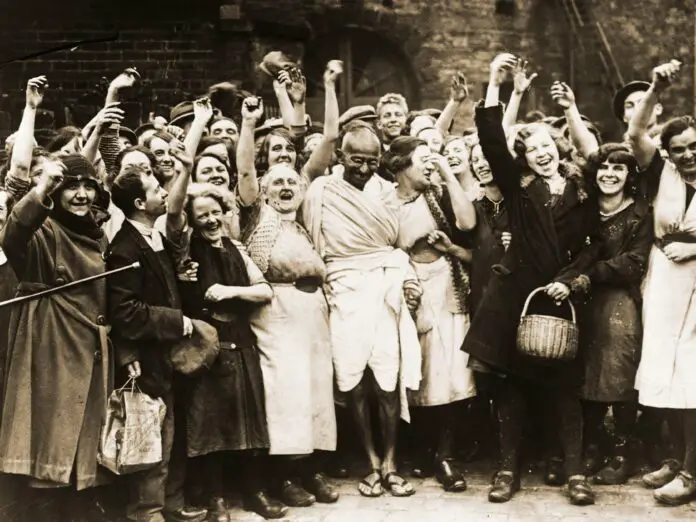He is a spiritual leader sometimes compared to Christ. The battle for the throne turned him into a man, and Indian nationalists certainly considered him a traitor. His indifference to the plight of black people in South Africa has been called racist by some, but one thing is for sure, he is one of the most influential figures of his twentieth century. He is ‘Gandhi’ or ‘Mohandas Karamchand Gandhi’ and his biography was featured in the film ‘Gandhi and Willpower’ which was broadcast in the ‘Historical Scenarios’. Our history is nothing but a series of amazing events. From the rise of millennia-old empires to the collapse of thriving civilizations, from the genius of a handful of pioneers to the development of global cultures, each of us can influence the process. Revolutions, from the worst tyrannical visions to the devastating outbreak of war, and from the heroic resistance of entire nations to the iron determination of certain minorities. On May 26, 1893, Gandhi, a young lawyer registered with the London Bar Association, was mercilessly thrown from a train in South Africa. On January 13, 1897, angry protesters attacked Gandhi and his family, threatening to hang him from a tree. In March 1930, Gandhi began his march across India, followed by tens of thousands of Indians. These three closely related events of his are key moments in Gandhi’s life. They led to the liberation of former British colonies.
The East India Company…
The First Steps of the British Royal Family India is one of the world’s oldest settlements. Many invaders were able to cross the mountains from the west and enter the Indus Valley. India is the river for which it is named, and the history of the region spans many empires, including the ‘Ashoka Empire’, the vast ‘Roman Empire’ at its height, and the ‘Gupta Empire’, India’s true golden age. spans India materialized. I am here. However, none of these empires had full control over this vast and highly complex country from north to south until the 17th century. Because there is not one India, but multiple “Indians” with limitless religious beliefs and practices. At the same time, over the centuries, the Indian society has developed an unbalanced, caste-based social system in which individuals are strictly divided into hierarchical groups: the rest of society. On December 31, 1600, London entrepreneurs established the British East India Company, granting overwhelming privileges to Indian princes in exchange for British protection, thereby opening up trade and commerce between Britain and India. Wealth flew between markets, and vast plantations produced vast amounts of agricultural produce. All the cotton was shipped to England, where it was woven in huge mills, and soon the Indian market was flooded with British textiles, and the vestiges of the traditional Indian economy gradually disappeared. India submitted to the British Crown and Queen Victoria of Great Britain became Empress of India and this was the birth of the ‘British Raj’ or Great Britain dominate India. The British Empire did not excel in this, just as the caste system ruled India. The inhabitants of the empire are not equal. In other colonies, as was the case in South Africa, the condition of blacks was considered depraved, while Asians were effectively slaves.
On December 19, 1896, ‘Gandhi’ returned to South Africa with her family after a short stay in India, but as soon as she arrived at ‘Durban Harbor’, the authorities quarantined the ship, causing strange White Europeans were also segregated. Allow disembarkation. Rumors spread throughout the city that Gandhi deliberately brought the plague to South Africa. At the dock, a crowd of protesters shouted insults and death threats against Indian passengers, and ‘Gandhi’ realized he was intended by the stone, not the ship, and was allowed to go to the beach with his family. Got it, but at night and with a police escort. Once on the sidewalk, protesters emerged from their hiding places and rushed toward small groups, and the situation quickly spiraled out of control. Later, the police chief’s wife arrived at the scene of the accident when she was passing by in a carriage on her way home from having dinner in the city. I was with an escort. To the anger of this woman and the cries of an angry crowd demanding his execution.
Politics of disobedience and non-violence. Rebellious Poor Revolution
On August 5, 1904, Gandhi could not sleep. He couldn’t stop thinking about what he read earlier that day. An impressive book by John Ruskin of Criticism of the Economic System. British writers make it clear that the production of goods and wealth requires human well-being, and that all must not come at the expense of economic gain. These ideas are similar to the “ahimsa concept”. It is a Hindu religious concept that we must respect the life that exists in all things.
Thorough reflection inspired ‘Gandhi’ to incorporate new ideas into his daily practice. I completely changed my lifestyle because some people eat a lot and others can’t. He made a mark and decided to fast regularly. He cut his hair first and started cleaning his bathroom. In his view, these are no longer menial tasks, and every human being must take care of his own needs.
In many cases he witnessed violence against women; He associated sex with violence, and so he swore not to marry. putting into practice a new principle of civil disobedience and non-violence; It is the principle of Satyagraha which boils down to “Say no to injustice firmly and openly, sometimes illegally, but never violence, and accept the consequences of your actions.”
On July 31, 1907, when the government decided that all Indians should be registered with the authorities, and their identities should be shown at all times, Gandhi found an opportunity to test his method after he became an influential leader, so he suggested that the Indians in South Africa refuse to cooperate, and this led to To the imprisonment of thousands, including “Gandhi” himself.
on August 16, 1908, in a public place, under the watchful eyes of the police; He went so far as to persuade thousands to burn their registration papers, and after being severely beaten, he again ended up behind bars. This brutal British response prompted Gandhi to write that he had discovered the source of evil. Western civilization and modernity. Some of the laws were repealed in 1913 and Gandhi decided to return to India the following year. Gandhi endured beatings and humiliations without reacting From his point of view, this was proof of self-control and therefore moral strength, and when ‘Gandhi’ went on hunger strike, the Indians saw it as proof of his determination, whereas the British point of view From, this is a sign of weakness and cowardice, so after two centuries of occupation of India, the British still do not understand Indian society and respond to protests with expressions of violence.
‘Great Spirit’… Civil Disobedience Paralyzes India, Opens Cell Doors On January 9, 1915, Gandhi arrived in Bombay, where his compatriots welcomed him, So he started traveling all over India listening to people and found that the situation was worse than he thought. Misery was everywhere, Britain controlled all of the country’s resources, famine struck again, people flocked to the slums, and wretched India lost its dignity. ‘Gandhi’ decided to take action and established a monastery-like ‘ashram’ in Indian civilization and began training his disciples in non-violence. ” or “great spirit”. At first, Gandhi didn’t know exactly how to act. On March 30, 1919, he organized a nationwide strike that paid off. All of India responded to his call for a general strike, completely paralyzing the country. However, this show of power landed him in prison again, and soon protests began against his support. A shore excursion that breaks taboos with salt. Fighting for Independence On April 13, 1919, British General Reginald Dyer, determined to teach the Indians a good lesson, attacked peaceful, unarmed crowds with modern rifles without warning his men. He was ordered to shoot children and carried out a horrific massacre and surprisingly, Gandhi, hitherto devoted to obtaining additional rights for Indians, made a final statement on the legitimacy of the British government which became his goal of complete independence. I put it out lost the illusion Gandhi took office as Speaker of Parliament and soon announced his program calling for a boycott of British schools, courts and products, a tax freeze and all police and military posts. It depended on the Indians. But it was helped by the fact that Britain had a population of less than 100,000 and the only answer they offered was violence and brutal repression. In March 1930, British authorities ordered Gandhi to evade a law that forced Indians to buy British salt by going to the beach to collect and sell it themselves, driving 400 miles around the country. (400 kilometers) of salt was announced to have been removed. I know that I have begun my march to the open sea. Had he been alone he would have been unremarkable, but he was accompanied by tens of thousands of Indians. A wave of people opposing the UK ban. More than 60,000 people were arrested and put in overcrowded prisons, but nothing changed. For Gandhi, this was just the beginning of a long resistance movement. He then moved peacefully from one part of the country to another, recruiting people for his cause.
Leaving India… Britain’s final battle exhausted in World War.
In 1942 during World War II, Gandhi published his manifesto ‘Stop India’. Meanwhile, British Prime Minister Winston Churchill cracked down on what he called hate speech, arrested all MPs and killed more than 1,000 protesters, but after the war Churchill lost the Labor election. Now seems to be the time for the Labor pro-Independence Party to come to power. India is nearing independence, but its liberation brings new challenges. Indian society is complex. For example, caste system inequality accompanies some religions, particularly Hinduism, in addition to the incompatibility between Hinduism and Islam. Muslims, who live primarily in the north, are unevenly distributed across the country, making up about 16% of the population and making up India’s largest ethnic minority, escalating tensions between the two communities.

Gandhi tries to end the conflict and preserve the unity of the country. In return, the British powers recognize these divisions in Indian society and use them as bargaining chips. If India becomes independent, the country will be divided. It’s a divide-and-conquer policy. Indian independence torn… defeat and triumph of sectarian strife Without Churchill, independence is within reach, but the struggle is far from over. Muhammad Ali Jinnah, one of the leaders of the Muslim “independence” movement, proposed dividing India into two states. Pakistan is for Muslims and the rest for Hindus. For Gandhi, this separation would be a catastrophic failure. Riots broke out across the country Hindus and Muslims try to fight back. What he can do to unite India against Ali Jinnah, who officially condemns anti-Hindu protests and promotes separatism? Later, independence was proclaimed with a chorus of “Victory of Mahatma Gandhi”. But the old man is not there. He was fed up and couldn’t share his joy. One is India and the other is Pakistan going in the opposite direction, causing conflict. It inevitably continued, made worse by the massacre. “Gandhi” tirelessly traveled across the country, promoting non-violence, with great success. The problems stop while he travels, but often start again after he leaves. A year later, Gandhi was shot three times on his way to Morning Prayer by a young Hindu nationalist who believed Mahatma to be a traitor.



